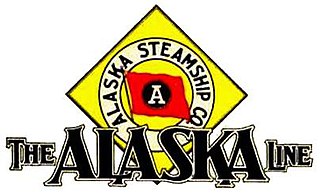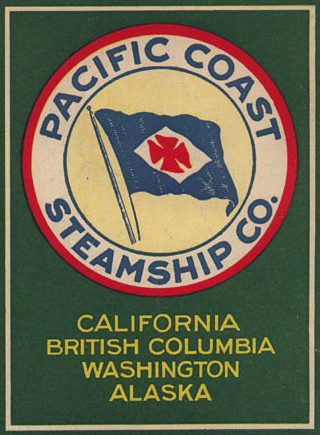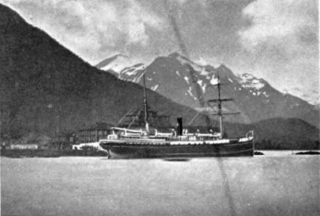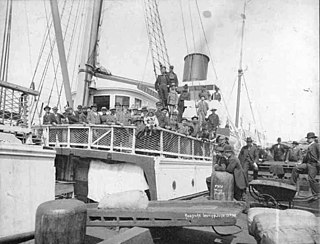
The Pacific Mail Steamship Company was founded April 18, 1848, as a joint stock company under the laws of the State of New York by a group of New York City merchants. Incorporators included William H. Aspinwall, Edwin Bartlett, Henry Chauncey, Mr. Alsop, G.G. Howland and S.S. Howland.

SS Valencia was an iron-hulled passenger steamer built for the Red D Line for service between Venezuela and New York City. She was built in 1882 by William Cramp and Sons, one year after the construction of her sister ship Caracas. She was a 1,598-ton vessel, 252 feet (77 m) in length. In 1897, Valencia was deliberately attacked by the Spanish cruiser Reina Mercedes off Guantanamo Bay, Cuba. The next year, she became a coastal passenger liner on the U.S. West Coast and served periodically in the Spanish–American War as a troopship to the Philippines. Valencia was wrecked off Cape Beale, which is near Clo-oose, on the west coast of Vancouver Island, British Columbia, on 22 January 1906. As her sinking killed 100 people, some classify the wreck of Valencia as the worst maritime disaster in the "Graveyard of the Pacific", a famously treacherous area off the southwest coast of Vancouver Island.

The Alaska Steamship Company was formed on August 3, 1894. While it originally set out to ship passengers and fishing products, the Alaska Steamship Company began shipping mining equipment, dog sleds, and cattle at the outbreak of the Klondike Gold Rush of 1897. The company was purchased by the Alaska Syndicate and merged with the Northwestern Steamship Company in 1909, but retained its name, and the fleet was expanded to 18 ships. During World War II, the government took over the company's ships. When the war ended, the company struggled to compete with the new Alaska Highway for passengers and freight. It discontinued passenger service altogether in 1954 and shut down operations in 1971.

Inter-Island Steam Navigation Company was headquartered in Honolulu and ran steamship passenger and cargo service between the Hawaiian Islands from 1883 until 1947. Inter-Island constructed the Kona Inn in 1928, the first hotel in Kona on the Big Island of Hawaii. In 1929, Inter-Island created an airline subsidiary, Inter-Island Airways, that is still operating as Hawaiian Airlines.

The Los Angeles Steamship Company or LASSCO was a passenger and freight shipping company based in Los Angeles, California.

SS Mauna Loa was a steam-powered cargo ship of the Matson Navigation Company that was sunk in the bombing of Darwin in February 1942. She was christened SS West Conob in 1919 and renamed SS Golden Eagle in 1928. At the time of her completion in 1919, the ship was inspected by the United States Navy for possible use as USS West Conob (ID-4033) but was neither taken into the Navy nor commissioned.

SS Columbia (1880–1907) was a cargo and passenger steamship that was owned by the Oregon Railway and Navigation Company and later the San Francisco and Portland Steamship Company. Columbia was constructed in 1880 by the John Roach & Sons shipyard in Chester, Pennsylvania for the Oregon Railway and Navigation Company.

The Pacific Coast Steamship Company was an important early shipping company that operated steamships on the west coast of North America. It was first organized in 1867 under the name Goodall, Nelson and Perkins. The Goodall, Nelson & Perkins Steamship Company was formed in 1875, but a year later was reorganized as the Pacific Coast Steamship Company. In 1916 the Admiral Line bought the shipping interests of the company.

SS Oregon (1878–1906) was a coastal passenger/cargo ship constructed in Chester, Pennsylvania by the Delaware River Iron Ship Building and Engine Works in February 1878. Originally delivered to the Oregon Steamship Company, she was used on the Portland, Oregon-to-San Francisco, California route for many years. In 1879, the Oregon Railroad and Navigation Company became the Oregon′s new owners after purchasing the Oregon Steamship Company. Also included in this purchase were the steamships George W. Elder and City of Chester. While in O.R. & N service, Oregon served alongside SS Columbia, which made the first commercial use of Thomas Edison's incandescent light bulb. Like Oregon, Columbia was also built by John Roach & Sons in Chester, Pennsylvania. Over time, Oregon's hull became breached after a number of incidents. Furthermore, the hull had been weighted with concrete to the point where she was considered unsuitable for service as a passenger liner. After operating as a cargo ship, she was laid up in 1894 at Portland. In 1899, the Oregon was re-qualified to carry passengers once more. She was sold by O.R. & N the same year. Despite this, she was viewed as a cursed ship by her crew. On 26 December 1889 she sank Clan McKenzie in a collision in snow in the Columbia River at Coffee Rock 47 miles above Astoria, Oregon. Two of Clan McKenzie's crew killed, one injured. Her bow was damaged and she drifted ashore, later pulled off.

SS George W. Elder (1874–1935) was a passenger/cargo ship. Originally a U.S. east coast steamer, she was built by John Roach & Sons in Chester, Pennsylvania. The George W. Elder became a west coast steamer in 1876 and served with the Oregon Steamship Company, Oregon Railroad and Navigation Company, San Francisco and Portland Steamship Company and the North Pacific Steamship Company. In 1907, the George W. Elder helped to rescue the survivors of her former running mate Columbia. The last owners of the George W. Elder were a Chilean firm which operated her under the name America. She operated the Chilean Coast under this guise until 1935, when she was finally scrapped. The location of her scrapping remains unknown.

SS Roanoke (1882–1916) was a passenger and cargo ship built by John Roach & Sons in Chester, Pennsylvania. The Roanoke was built for the Old Dominion Steamship Company's service from New York to Norfolk Virginia. In 1898 the ship was sold to the North American Transportation and Trading Company to take miners, supplies and gold between Seattle and ports in Alaska. Later the Roanoke was sold to the Oregon-based North Pacific Steamship Company. In 1907, the Roanoke helped to rescue the survivors of her former running mate Columbia. On May 9, 1916, the Roanoke sank in heavy seas off the California coast near San Luis Obispo with the loss of 47 lives. There were only three survivors.

West Kasson was a steam cargo ship built in 1918–1919 by Long Beach Shipbuilding Company of Long Beach for the United States Shipping Board (USSB) as part of the wartime shipbuilding program of the Emergency Fleet Corporation (EFC) to restore the nation's Merchant Marine. The vessel initially operated on the round-the-world route from the West Coast of the United States via East Asia and Spain before being shifted to serve the Gulf to Europe and South America trade in 1922. In 1926 she was sold to the W. R. Grace and Company and renamed Cuzco. In her new role the ship operated chiefly between the ports of the Pacific Northwest and various Chilean and Peruvian ports. In 1940 the ship was again sold and transferred into Panamanian registry and renamed Carmona. The vessel continued sailing between South America and the United States and was torpedoed and sunk by the German submarine U-160 on one of her regular trips in July 1942.
West Hika was a Design 1013 cargo ship built in 1919 by the Los Angeles Shipbuilding & Dry Dock Co of Los Angeles. She was one of many ships built by the company for the United States Shipping Board.
West Montop was a Design 1013 cargo ship built in 1919 by the Los Angeles Shipbuilding & Dry Dock Co of Los Angeles. She was one of many ships built by the company for the United States Shipping Board.

The steamship General Frisbie was a wooden two-deck passenger ship built in 1900, named after John B. Frisbie. She was designed for use as a ferry between Vallejo and San Francisco. The steamer was successful in that role and was the fastest ship on the route when she began service. Improved roads, bridges, and automobiles reduced demand for ferry service in the Bay Area, and newer ships were optimized for transporting cars, so General Frisbie was retired in the late 1920s.

Ancon was an ocean-going wooden sidewheel steamship built in San Francisco in 1867. She carried both passengers and freight. In her early career she was a ferry in Panama and then ran between Panama and San Francisco. Later she began coastal runs between Sand Diego and San Francisco. Her last route was Port Townsend, Washington to Alaska. Today she is more notable for her disasters than her routine voyages. Ancon Rock in Icy Strait, Alaska is the site of her 1886 grounding. Her final wreck, in 1889 in Naha Bay, near Loring, Alaska was commemorated by Albert Bierstadt. His painting, "Wreck of the 'Ancon' in Loring Bay, Alaska" now hangs in the Museum of Fine Art in Boston.

Idaho was a wooden steamship built for Pacific Coast passenger and freight service. She was launched in 1866 and wrecked in 1889. She was one of the first ocean-going steamships to provide regular service to the northwest coast of North America.

Wheatland Montana was a steam cargo ship built in 1919 by Skinner & Eddy of Seattle for the United States Shipping Board as part of the wartime shipbuilding program of the Emergency Fleet Corporation (EFC) to restore the nation's Merchant Marine. The freighter spent the majority of her career in the Pacific connecting the West Coast of the United States with the Chinese and Japanese ports in the Far East. Early in 1928 the ship together with six other vessels was sold by the Shipping Board to the Tacoma Oriental Steamship Co. and subsequently renamed Seattle. After her owner declared bankruptcy early in 1937, the freighter was sold to Matson Navigation Company and renamed Lihue. She was then mainly employed to transport sugar and canned fruit from the Hawaiian Islands to the ports on the East Coast of the United States. In February 1942 she was chartered to transport general cargo and war supplies to the Middle East but was torpedoed by U-161 in the Caribbean Sea on February 23, and eventually sank three days later while in tow without loss of life.

The City of Seattle was a passenger steamship built in 1890 in Philadelphia, Pennsylvania. The City of Seattle operated out of Puget Sound from 1890 to 1921, during which it ran routes between the local ports as well as Alaska, notably transporting prospectors during the Klondike Gold Rush. In 1921, the City of Seattle returned to the East Coast where it ran routes in both New York and Florida. In 1937, the City of Seattle returned to Philadelphia to be scrapped.

Senator was a steel-hulled steamship launched in 1898. She served as a troopship during the Spanish-American War and was an important part of the Nome gold rush. She spent thirty years in the coastwise shipping trade between Alaska and San Diego, until she was scrapped in Osaka, Japan in 1935.


















